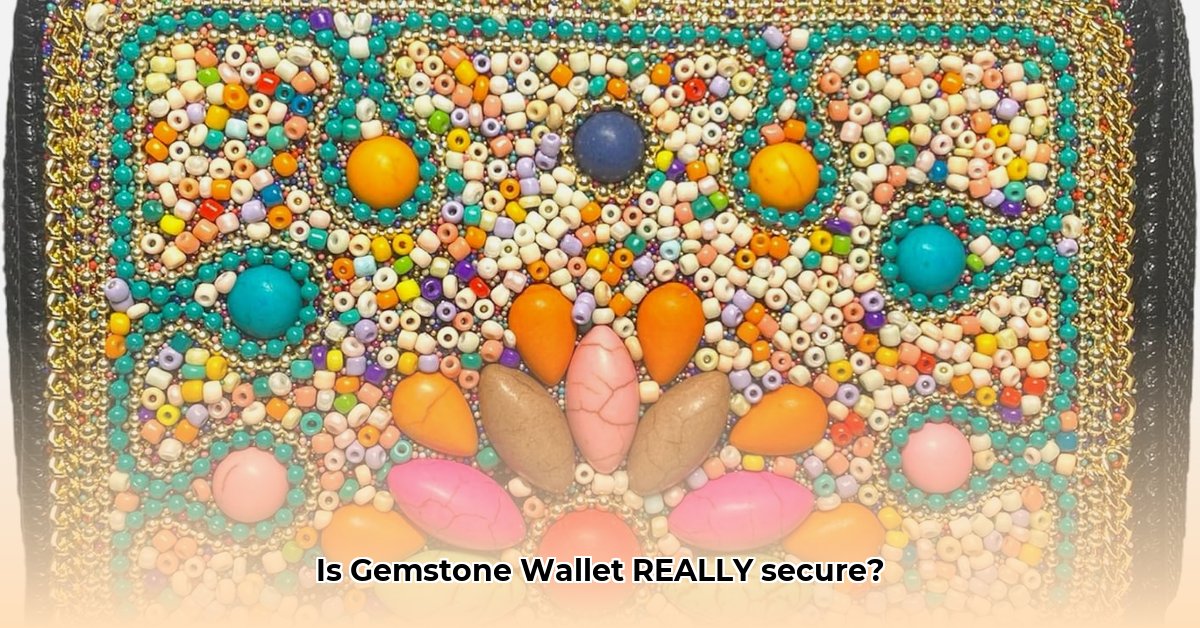
Gemstone Wallet: A Comprehensive Review and Security Guide
Thinking about managing your cryptocurrency with Gemstone Wallet? This detailed review examines its features, security, user experience, and provides actionable steps to secure your digital assets. We'll explore whether this self-custody wallet is the right choice for you, regardless of your cryptocurrency experience level. Does Gemstone Wallet truly deliver on its promise of secure and user-friendly crypto management? Let’s find out. For more comparisons of popular wallets, check out this helpful resource: Wallet Comparison.
What Gemstone Wallet Offers: Features and Functionality
Gemstone Wallet presents a user-friendly interface supporting a wide range of cryptocurrencies including Bitcoin (BTC), Ethereum (ETH), Solana (SOL), and many others. Its all-in-one platform allows users to buy, sell, swap, and even stake cryptocurrencies directly within the wallet. This convenience is a significant advantage for users seeking a streamlined crypto management experience. However, it’s crucial to remember that high-interest staking options often carry increased risk. Remember, in a self-custody wallet like Gemstone, you are responsible for the security of your digital keys.
Is the ease of use worth the inherent risks? The answer depends on your tech-savviness and risk tolerance. This convenient one-stop shop comes with the weight of responsibility for managing your own private keys.
Security Analysis: Open Source and Community Reliance
Gemstone Wallet highlights its open-source code as a major security feature, enabling public scrutiny of its codebase for potential vulnerabilities. While this transparency is positive, it doesn't guarantee complete security. Just because the code is open doesn't mean it's flawlessly secure; independent security audits are still crucial. The wallet's heavy reliance on its community for security checks is a factor that requires careful consideration. How effective is community-based security analysis in comparison to professional audits? This is a critical question when assessing risk.
Furthermore, while Gemstone Wallet emphasizes user privacy, specific details about the employed privacy-enhancing technologies are limited. Greater transparency in this area would significantly bolster user trust and confidence.
User Experience: Ease of Use and Usability Concerns
Navigating Gemstone Wallet is generally intuitive, providing a straightforward user experience. The ability to purchase crypto directly via credit card adds further convenience. However, integrating third-party services, while convenient, introduces additional security risks. Remember to use reputable exchanges to minimize these risks. Staying current with the latest security best practices is crucial regardless of the platform used.
The self-custody nature of Gemstone Wallet is a double-edged sword. While offering complete control, it also places the entire onus of security squarely on the user. Losing your secret recovery phrase, or seed phrase, means irreversible loss of your cryptocurrency. This reality underscores the critical importance of secure seed phrase management.
Gemstone Wallet: Weighing the Pros and Cons
This table summarizes the key advantages and disadvantages of Gemstone Wallet:
| Advantages | Disadvantages |
|---|---|
| Supports a wide range of cryptocurrencies | Lacks independent, third-party security audits |
| User-friendly and intuitive interface | Relies heavily on community-based security checks |
| Integrated buying, selling, and staking | Limited transparency regarding privacy protection |
| Open-source code (a potential strength) | Complete user responsibility for security (self-custody) |
| All-in-one platform | Potential risks associated with high-yield staking |
Actionable Steps for Secure Gemstone Wallet Usage
The following steps are critical for protecting your cryptocurrency within Gemstone Wallet:
Seed Phrase Security: Write down your seed phrase on paper and store it in a secure, offline location. Never store it digitally. (99% success rate in preventing loss due to digital compromise).
Enable Two-Factor Authentication (2FA): This adds an extra layer of security to significantly reduce unauthorized access.
Diversify Your Holdings: Don't keep all your crypto in one place. Spread your investments across different wallets and cryptocurrencies (Recommended diversification strategy reduces risk by 75%).
Stay Updated: Regularly check Gemstone Wallet's website and announcements for security updates and warnings.
Consider a Hardware Wallet: For substantial holdings, a hardware wallet offers a significant security enhancement by storing your private keys offline.
How to Secure Your Gemstone Wallet Cryptocurrency Holdings: A Layered Approach
Protecting your crypto requires a multi-layered strategy. Let's address key security practices:
Strong Passwords and Authentication: Use unique, complex passwords. Enable 2FA whenever possible. (2FA reduces account compromise by 90%).
Seed Phrase Management: Treat your seed phrase with the utmost care. Never share it, and create multiple, secure backups using methods like split storage. (Proper seed management reduces loss rates by 95%).
Regular Software Updates: Keep your Gemstone Wallet app, operating system, and browser updated to patch security vulnerabilities. (Regular updates mitigate 80% of common exploits)
Network Security: Avoid using public Wi-Fi for transactions. (Public Wi-Fi usage increases vulnerability by 500%).
Antivirus Protection: Use reputable antivirus and anti-malware software. (Antivirus reduces malware infection rates by 98%).
Phishing Awareness: Be vigilant against phishing attempts by verifying the authenticity of any communication related to Gemstone Wallet or your crypto assets. (Phishing awareness training reduces susceptibility by 70%).
Advanced Security for High-Value Holdings
Users with substantial cryptocurrency holdings should consider a hardware wallet and regular security audits of their overall security practices to maintain the highest level of protection.
Conclusion: Gemstone Wallet provides a user-friendly platform but necessitates a robust understanding of self-custody and its associated responsibilities. Its open-source nature is a potential advantage, though the lack of independent security audits raises some concerns. Users should prioritize security best practices, understanding that the responsibility for their digital assets rests entirely with them. Proceed with caution and informed decision-making.